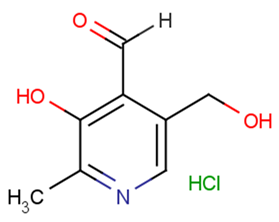
Pyridoxal hydrochloride
CAS No. 65-22-5
Pyridoxal hydrochloride( —— )
Catalog No. M19654 CAS No. 65-22-5
The 4-carboxyaldehyde form of vitamin B6 which is converted to pyridoxal phosphate which is a coenzyme for synthesis of amino acids neurotransmitters (serotonin norepinephrine) sphingolipids aminolevulinic acid.
Purity : >98% (HPLC)
 COA
COA
 Datasheet
Datasheet
 HNMR
HNMR
 HPLC
HPLC
 MSDS
MSDS
 Handing Instructions
Handing Instructions
| Size | Price / USD | Stock | Quantity |
| 500MG | 37 | In Stock |


|
| 1G | Get Quote | In Stock |


|
Biological Information
-
Product NamePyridoxal hydrochloride
-
NoteResearch use only, not for human use.
-
Brief DescriptionThe 4-carboxyaldehyde form of vitamin B6 which is converted to pyridoxal phosphate which is a coenzyme for synthesis of amino acids neurotransmitters (serotonin norepinephrine) sphingolipids aminolevulinic acid.
-
DescriptionThe 4-carboxyaldehyde form of vitamin B6 which is converted to pyridoxal phosphate which is a coenzyme for synthesis of amino acids neurotransmitters (serotonin norepinephrine) sphingolipids aminolevulinic acid.
-
In Vitro——
-
In Vivo——
-
Synonyms——
-
PathwayOthers
-
TargetOther Targets
-
RecptorOthers
-
Research Area——
-
Indication——
Chemical Information
-
CAS Number65-22-5
-
Formula Weight203.62
-
Molecular FormulaC8H10ClNO3
-
Purity>98% (HPLC)
-
SolubilityDMSO:10 mM
-
SMILESCl.Cc1ncc(CO)c(C=O)c1O
-
Chemical Name——
Shipping & Storage Information
-
Storage(-20℃)
-
ShippingWith Ice Pack
-
Stability≥ 2 years
Reference
1.Rajamohan F Nelms L Joslin D L et al. cDNA cloning expression purification distribution and characterization of biologically active canine alanine aminotransferase-1.[J]. Protein Expr Purif 2006 48(1):81-89.
molnova catalog



related products
-
P300/CBP-IN-3
P300/CBP-IN-3 is an inhibitor of p300/CBP histone acetyltransferase.
-
Ampelopsin G
Ampelopsin G is a natural product for research related to life sciences.
-
Ganoderic acid GS-2
Ganoderic acid GS-2 can inhibit the activity of human immunodeficiency virus -1 protease.



 Cart
Cart
 sales@molnova.com
sales@molnova.com


